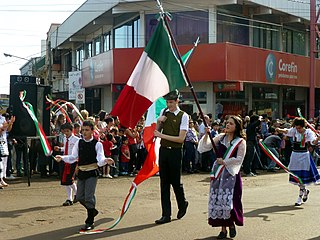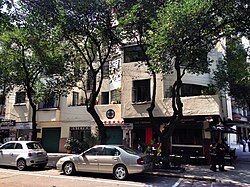Asian Latin Americans are Latin Americans of Asian descent. Asian immigrants to Latin America have largely been from East Asia or West Asia. Historically, Asians in Latin America have a centuries-long history in the region, starting with Filipinos in the 16th century. The peak of Asian immigration occurred in the 19th and 20th centuries. There are currently more than four million Asian Latin Americans, nearly 1% of Latin America's population. Chinese, Japanese, and Lebanese are the largest Asian ancestries; other major ethnic groups include Filipinos, Syrians, Indians, and Koreans. Brazil is home to the largest population of East Asian descent, estimated at 2.08 million. The country is also home to a large percentage of West Asian descendants. With as much as 5% of their population having some degree of Chinese ancestry, Peru and Mexico have the highest ratio of any country for East Asian descent. Though the most recent official census, which relied on self-identification, gave a much lower percentage.

Asian Argentines, are Argentine citizens or residents of Asian ancestry. The vast majority trace their ancestry to West Asia, primarily Lebanon and Syria, and East Asia, namely China and Japan. Though there are other communities of South Asian or Southeast Asian origin as well. Asian-Argentines settled in Argentina in large numbers during several waves of immigration in the twentieth century.
Latin American Canadians are Canadians who are descendants of people from countries of Latin America. The majority of Latin American Canadians are multilingual, primarily speaking Spanish, Portuguese, French and English. Most are fluent in one or both of Canada's two official languages, English and French. Spanish and Portuguese are Romance languages and share similarities in morphology and syntax with French.

Arab Brazilians are Brazilian citizens of Arab ethnic, cultural, linguistic heritage and identity. The majority of Arab Brazilians trace their origin to the Levantine region of the Arab World, known in Arabic as Bilad al-Sham, primarily from Lebanon and Syria, as well as Palestine. Arab Brazilians are Christians in the great majority. The first Syrians and Lebanese arrived in São Paulo around 1880. It is not known exactly when, although the Syrians and Lebanese say that in 1885 there was a small core of peddlers working in the market square. By 1920, the census listed 50,246 Syrians and Lebanese in Brazil, 38.4% (2/5) of these in the state of São Paulo. The 1940 census enumerated 48,614 Syrians, Lebanese and other related groups with a decrease of approximately 1647 people. As immigration almost ceased after 1929 and the colony aged, it is surprising that the decline was not even greater. The trend of the period between 1920 and 1940 was the continuous concentration of Syrians and Lebanese in São Paulo. Almost half (49.3%) of Syrians and Lebanese residents in Brazil lived in São Paulo.

Italian Mexicans are Mexican-born citizens who are fully or partially of Italian descent, whose ancestors were Italians who emigrated to Mexico during the Italian diaspora, or Italian-born people in Mexico. The ancestors of most Mexicans of Italian descent arrived in the country during the late 19th century. Their descendants have generally assimilated into mainstream Mexican society.
Vázquez is a surname of Galician origin, which later spread all over the Spanish-speaking world. Alternative spellings of the name include Vásquez or Vasques, and Vazquez or Vasquez in countries where Iberian languages are not commonly spoken.
Chilean Americans are Americans who have full or partial origin from Chile.
Arab Mexicans are Mexican citizens of Arab ethnic lineage, who identify themselves as Arab. Some of Mexico's Arabs are of Lebanese, or Palestinian descent.
British Moroccans are citizens and/or residents of the United Kingdom whose ethnic origins lie fully or partially in Morocco.

Italian Argentines are Argentine-born citizens who are fully or partially of Italian descent, whose ancestors were Italians who emigrated to Argentina during the Italian diaspora, or Italian-born people in Argentina.

A French Chilean is a Chilean citizen of full or partial French ancestry. Between 1840 and 1940, 20,000 to 25,000 French people immigrated to Chile. The country received the fourth largest number of French immigrants to South America after Argentina (239,000), Brazil (150,341) and Uruguay.

Croatian Argentines are Argentine citizens of Croatian descent or Croatian-born people who reside in Argentina. Croats and their descendants settled in Buenos Aires, the homonymous province, Santa Fe, Córdoba, Chaco, and Patagonia. Argentines of Croatian descent number over 250,000.
Mexican immigration to Spain refers to the Mexican population in Spain and their Spanish-born descendants. The Mexicans living in Spain are composed primarily of students, skilled professionals, spouses of Spaniards, as well as Mexican citizens who also have Spanish nationality. In December 2008, the National Statistics Institute in Spain had 14,399 registered Mexicans within its territory, of which 7,210 hold other nationalities of the European Union or are family members of EU citizens. To this number must be added those with dual nationality, who are not in Spanish records as foreigners. Mexican and Spanish laws allow dual citizenship, and many Mexicans who have asked for it, whether they are residents in Spain as grandchildren or they are children of Spanish migrants to Mexico. In 2010, the Ministry of Foreign Affairs of Mexico recorded 21,107 Mexicans living in Spain, who became the third largest Mexican community residing abroad, after the United States and Canada; and the largest Mexican community in Europe.

Lebanese Mexicans refers to Mexican citizens of Lebanese origin.

There is a significant Colombian diaspora in Mexico. According to the 2020 census, there were 36,234 Colombian citizens residing in Mexico, making them the second largest South American immigrant community in Mexico.

There is a small Chilean diaspora in Mexico. According to the 2010 census, there were 5267 registered Chilean citizens living in Mexico, an increase from the 3,848 registered in the 2000 census. Chilean immigrants constitute the fifth largest community of South Americans in Mexico and the fifteenth largest immigrant community overall.

Britons in Mexico, or British Mexicans, are Mexicans of British descent or British-born persons who have become naturalized citizens of Mexico.
At the 2011 census, the number of immigrants in Costa Rica totaled about 390,000 individuals, or about 9% of the country's population. Following a considerable drop from 1950 through 1980, immigration to Costa Rica has increased in recent decades.
Latin American migration to Europe is the diaspora of Latin Americans to the continent of Europe, dating back to the first decades of the Spanish and Portuguese empires in the Americas. Latin Americans in Europe are now a rapidly growing group consisting of immigrants from Argentina, Bolivia, Brazil, Chile, Colombia, Costa Rica, Cuba, Dominican Republic, Ecuador, El Salvador, Guatemala, Honduras, Mexico, Nicaragua, Panama, Paraguay, Peru, Puerto Rico, Uruguay and Venezuela. It may also include individuals from certain French-speaking territories depending on the definition of Latin America used.













